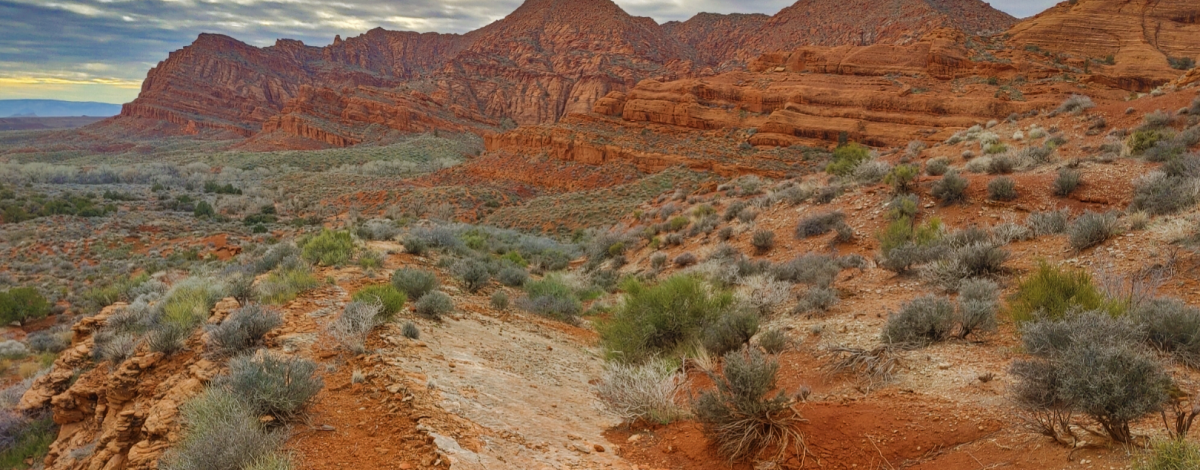Some information may be outdated.
This week’s Science Moab is from a special collaboration with the Southern Utah Science Café in St. George. Similar to Science Moab, the Southern Utah Science Café podcast hosts scientists to talk about topics that impact our daily lives. Here, scientists Jerry Harris and Lura Snow talk about the geology in Red Cliffs National Conservation Area and the critical habitat for the desert tortoise.
Southern Utah Science Cafe: What causes the cliffs in Red Cliffs National Conservation Area to look like they do?
Jerry Harris: The red color of the cliffs is mostly due to little quartz grains in the rock, each coated with a little tiny coating of a mineral called hematite, which is basically the naturally occurring form of rust. Most red cliffs are part of a rock unit called the Navajo Sandstone, which is about 180 million years old. They represent a time in Earth’s history when there was a vast desert, specifically an erg, which is basically just a field of sand dunes as far as the eye can see. This erg stretched from Central Arizona and New Mexico all the way up into Idaho and it spanned from western Colorado into southeastern California. It was the biggest erg we know of in all of Earth’s history.
Science Cafe: How do dunes go from sand to sandstone and back again?
Harris: Dunes migrate and climb on top of one another, so older dunes get buried underneath younger dunes. Once they’re buried, the individual little quartz grains are compacted together. As groundwater flows through the little pore spaces in between all of the individual grains, it deposits minerals, including things that will cement each of those grains together. The Navajo Sandstone weathers fairly easily, and the grains come apart because there’s not a ton of cement in those pore spaces. The modern dunes in Snow Canyon State Park and Coral Pink Sand Dunes are from Navajo Sandstone re-eroding and re-weathering. If those dunes end up getting buried, they could eventually form a new set of sand dune-based rocks at some point in the future.
Science Cafe: What did the world and its lifeforms look like when the erg was here?
Harris: 180 million years ago was just after Pangea started breaking apart, so the continents were only just over being connected to one another. Life at this point in time, especially in this corner of North America, is not particularly well-known because Navajo Sandstone rarely preserves fossils. We know most of the life forms that were in and around this ancient erg from mostly footprints. We have dinosaur footprints, mostly from meat-eating dinosaurs, but there were some larger and smaller plant-eating dinosaurs as well. There have actually been some fossil crocodile bones found in a portion of the Navajo Sandstone that’s a little bit farther to the east of us, in a little lake deposit. We know that there was some aquatic life in some of these inter-dune lakes. There are some fossils made by some invertebrates; some insects and arachnids left trace fossils, but we don’t know much about plant life.
Science Cafe: What does the Red Cliffs Desert Reserve do for tortoises?
Lura Snow: Over the last 150 years, as more people have moved into this Mojave desert ecosystem, we’ve been building things that humans “need” to live. We’ve been building houses, roads, stores, schools, and a really significant amount of infrastructure—and we’ve been building right on top of all of the things that the tortoises need to survive. As you’ve gotten more people, you’ve got fewer tortoises. All of that development led to such significant habitat loss for the tortoises that by the late 1980s, they were listed federally as a threatened species.
Tortoises need native grass, annuals, cactus fruit, wildflowers and a water source. They also need ample open space to roam. Here in Washington County, we had such a significant amount of development happening in the 1990s that we needed to take action to protect the tortoises. 62,000 acres of the Red Cliffs Desert Reserve were set aside for the preservation of the desert tortoise habitat, which then opened up the rest of the county to development.
Science Cafe: Has the reserve been successful in protecting tortoises?
Snow: For the last 26 years, when you want to build anything in desert tortoise habitat, we go out and survey the land that is going to be developed and remove any tortoises that we find. We’re actually able to set them free out into the protected habitat of the Red Cliffs Reserve. With that protected habitat, our population of desert tortoises here in Washington County, is actually one of the most healthy and functional populations of tortoises throughout the entire Mojave Desert. Our tortoises have good food sources and good water sources. So our tortoises here, because they have this protected habitat, are doing really well for a species that is struggling pretty significantly.
Science Cafe: Why shouldn’t we touch tortoises?
Snow: If you’re out on a hike and you see a tortoise living their best life, there’s no reason to touch that tortoise. Tortoises can go about a year without taking in any additional water because they can store the water they need inside their bladder. A tortoise that is frightened and voids its bladder runs the risk of not being able to ingest more water in a timely fashion. On the other hand, we’ve done such a good job of telling people to never touch the tortoises that we’re seeing instances where a tortoise is in trouble but people are so worried about getting in trouble for touching a tortoise, that they’re leaving a tortoise in danger.
Science Moab is a nonprofit dedicated to engaging community members and visitors with the science happening in Southeast Utah and the Colorado Plateau. To learn more and listen to full interviews, visit www.sciencemoab.org.
Appreciate the coverage? Help keep local news alive.
Chip in to support the Moab Sun News.





